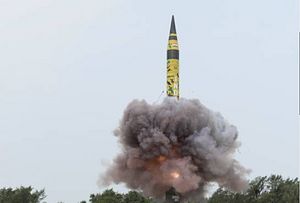India has successfully test fired its most advanced nuclear-capable intercontinental ballistic missile (ICBM), the Agni-V, the Indian Ministry of Defense (MoD) said in a statement. The missile was fired from a mobile launcher on June 3 at 9:45 a.m. local time from the Integrated Test Range on Abdul Kalam island in the Bay of Bengal off the coast of the eastern Indian state of Odisha.
“All the radars, electro optical Tracking stations and telemetry stations tracked the vehicle all through the course of the trajectory,” the MoD “All the mission objectives have been achieved.”
This marks the sixth test launch of the three-stage Agni-V ICBM, officially designated as an intermediate range ballistic missile (IRBM). The last test took place earlier this year on January 18. A previous test occurred in December 2016. Other tests occurred in January 2015, September 2013, and April 2012. All flight trials have officials been classified as successful.
“While two of the previous launches, taking place in April 2012 and September 2013 respectively, had the Agni-V tested in ‘open configuration,’ the January 2015 test involved the launch of ICBM from a hermetically sealed canister mounted on a mobile transporter erector launcher in so-called ‘deliverable configuration,’” I explained in December 2016. The June 3 and January 18 tests also involved Agni-Vs in deliverable configuration launched from sealed canisters.
The Agni-V provides India with a second-strike capability, as I noted previously:
The Agni-V, a three-stage solid fueled missile, has an approximate range of 5,500-5,800 kilometers [the exact range remains classified, but it is assumed that the missile has a range of 6,000-7,500 kilometers], and can carry a 1,500-kilogram (3,300-pound) nuclear warhead. India has reportedly also been working on multiple independently targetable reentry vehicles (MIRV) for the Agni-V in order to ensure a credible second-strike capability.
Additionally, I wrote earlier this year:
While previous nuclear-capable missiles of the series (Agni-I, Agni-II, and Agni-III) were developed to offset Pakistan’s nuclear arsenal, the Agni-IV,Agni-V and Agni-VI, given their longer ranges, are designed to provide a credible nuclear deterrent against China.
Both the Agni-V and Agni-VI will feature increased accuracy and a reduced launch time, which, paired with India’s burgeoning MaRV [maneuverable reentry vehicle] and MIRV capability, can have a destabilizing effect on the overall strategic balance in the region.
The June 3 test launch constitutes an important stepping stone toward user trials of the new weapon system by India’s Strategic Forces Command (SFC). According to sources, only one more pre-induction test launch is required before the missiles introduction into service with the SFC. An operational deployment of the Agni-V ICBM would require at least two additional test firings by the SFC.
India’s Defense Research and Development Organization has also been working on a next-generation ICBM, the Agni-VI, a four-stage ICBM with MIRV and MaRV capability with an estimated range of over 10,000 kilometers.

































